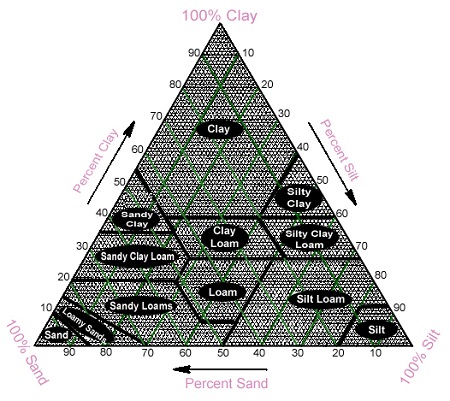The census bureau tells us that the average American will move about 12 times in a lifetime. The National Garden Association estimates that 100 million of these “average Americans” have gardens. It goes to reason then- this spring there are over 15 million people in the US who will be planning a garden in uncharted soil. When you find yourself in that 5%- here are some simple tips to see what you have to work with in your new home.
Identify the Texture
Soil can be divided into three basic groups by texture: sand, silt, and clay. The texture of your soil is an indication of its ability to retain nutrients and water. Sand is gritty, loose, and falls apart in your hand; clay is smooth & sticky when wet or hard and cracked when dry; silt is a middle ground, finer than sand but still feels gritty. The ideal soil is a well-proportioned combination of the three (loam) with a small amount of both living and dead organic material. The “shake it in a jar” method will give you a good idea of your proportions.

Find a Mason jar or any transparent, round, container with a lid. Gather enough soil from the area you are testing to fill the jar about half full. The sample shouldn’t be just scraped off the top. Include soil from the top to at least 8 inches below the surface in the area you are testing. If you can manage to wedge your shovel in deep enough to break out a chunk you can then use that same shovel to cut off a slice. Remove rocks, leaves, and bust up any clumps with a colander or sieve then let it dry. Pour your prepared sample into the jar and mark the height of the total soil sample on the outside of the jar.
Fill the jar almost full of water but leave at least two inches of shaking room. Add a teaspoon of salt. Give it a good long shake to completely break up any remaining clumps then set the jar in an undisturbed area. After 30 seconds, mark the depth of the sand that has settled on the bottom of your jar. Three minutes later mark the silt layer. The mark you already made should represent where the clay would ultimately settle. Now you can estimate the proportions of sand to silt to clay based on your marks. Use this information and apply it to the USDA triangle soil texture calculator and you have your soil type.
You can test the pH with common kitchen items as well by scooping some soil into a container and adding a half-cup of vinegar. If the soil bubbles or fizzes, it’s alkaline. If there’s no reaction, use more soil in a fresh container and mix first with a 1/2 cup of water, then add a half-cup of baking soda. If the soil bubbles or fizzes the soil is acidic. Amend your soil with wood ash or lime if it’s acidic. Amend with sulfur or pine needles if it’s alkaline. This is a good article that explains how to test the pH of your soil using homemade items and also explains how to correct it.
Remember that soil amendment takes time. Make small changes and give nature a chance to make use of your work before making more changes. Knowing the texture and pH of your soil are good first steps to determining the species of plants that will do best in your garden the first year. If you find your new home is a sandbox, you know your vegetable garden will need some extra water and nutrients. Choosing plants that are well suited to your soil type will save time and resources.
Angela Lundmark is a freelance writer that enjoys outdoor and indoor gardening.
Related Articles & Free Email Newsletter Sign Up
11 Organic Fertilizers That Can Help Your Soil
How to Amend Soil and Mulch with Organic Matter



Comment here